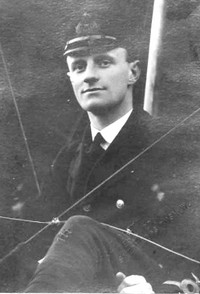Group Captain Paul Ward Spencer Bulman,, universally known as George Bulman, was a pilot whose flying life spanned thirty years (1915–1945).
Captain William Melville Alexander was a Canadian First World War flying ace, officially credited with 22 aerial victories.
Leonard Henry Rochford, was a British flying ace of the First World War, credited with 29 aerial victories. He returned to military service in the Royal Air Force during the Second World War.
Flight Lieutenant Godfrey Bremridge was a World War I flying ace who was credited with five victories.
Second Lieutenant Orlando Clive Bridgeman was a World War I flying ace credited with five aerial victories.
Edward Gribben was a World War I flying ace credited with five aerial victories. He became a lieutenant-colonel in the Territorial Army between the wars, returning to the RAF in World War II, and rising to the rank of squadron leader.
Herbert Gardner Travers, was a British flying ace of the First World War, credited with five aerial victories. He later worked in civil aviation and returned to service during the Second World War.
Lieutenant John Herbert Greenwood Womersley was a World War I flying ace credited with five aerial victories.
Group Captain George Cecil Gardiner was a World War I flying ace credited with six aerial victories.
Flight Lieutenant Geoffrey William Hemming was a British World War I flying ace credited with six aerial victories.
Lieutenant Thomas Archibald Mitford Stuart Lewis was a British World War I flying ace credited with six aerial victories.
Wing Commander Edward Duncan Crundall was an officer of the British Royal Air Force, who served in World War I, becoming flying ace credited with seven aerial victories, and also in World War II.

Captain Howard John Thomas Saint was a Welsh First World War flying ace credited with seven aerial victories. He became the chief test pilot for the Gloster Aircraft Company in the 1930s.
Captain John Todd (1899–1980) was a Scottish First World War flying ace credited with 18 aerial victories.
Captain George Brian Gates was a World War I flying ace credited with 15 aerial victories, twelve of them enemy aircraft, and three observation balloons.
Captain Maxwell Hutcheon Findlay was a World War I flying ace credited with 14 aerial victories. He remained in the RAF postwar for several years before going on to a civilian aviation career that ended with his death in the Johannesburg Air Race of 1936.
Francis Dominic Casey, was an Irish flying ace of the Royal Naval Air Service during the First World War, credited with nine aerial victories. He received the Distinguished Service Cross before his death during a test flight in 1917.
Captain George William Francis Darvill was an English World War I flying ace credited with nine aerial victories.
Captain George Henry Hackwill was an English World War I flying ace credited with nine aerial victories. His most notable victory was his role in shooting down a German Gotha G.V, over Essex on the night of 28 January 1918. This was the first victory ever achieved in combat between aircraft at night.




